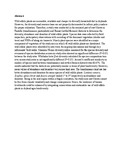Wild Edible Plants: A Potential To Enhance Agrobiodiversity And People’s Resilience To Changing Ecosystem

View/
Date
2011Author
Hunde, Feyssa Debela
Njoka, Jesse T.
Asfaw, Zemede
Nyangito, M. M.
Type
PresentationLanguage
enMetadata
Show full item recordAbstract
Wild edible plants are accessible, available and cheaper to diversify household diet in drylands. However, the diversity and resource base are not properly documented to inform policy makers for proper utilization. Therefore, a study was conducted in the semiarid part of east Shewa in Fantalle (transhumance pastoralists) and Boosat (settled farmers) districts to determine the diversity, abundance and densities of wild edible plants. Species data was collected by field inspection, participatory observations with recording of the dominant vegetation (shrubs and trees) and WEPs of along six transects. Ninety plant species were identified as a major component of vegetation of the study area in which 40 wild edible plants are distributed. The wild edible plants were identified by interview, focus group discussions and through key informants’ field walks. Shannon-Weiner diversity indice measured for the species diversity and evenness of species distribution across six study sites showed no significant difference (P>0.05) between the study sites. Whithaker beta (βw) diversity calculated for species composition turn-over across study sites is not significantly different (P>0.05). Jaccard’s coefficient similarity in number of species used between transhumance and settled farmers districts was 66.67%. The results indicated that the districts are potentially similar in terms of plant biodiversity. However, mean values of abundance and densities vary across land uses. The transhumance land use has better abundances and densities for some species of wild edible plants. Lantana camara, Ziziphus spina-christi and Acacia senegal ranked 1st to 3rd respectively in abundance and densities. Being in the arid region within a fragile ecosystem, the study area east Shewa cannot be free from climate variability and change consequences. Hence, the resilience of human livelihoods could be enhanced by integrating conservation and sustainable use of wild edible plants in dryland agro-biodiversity.
